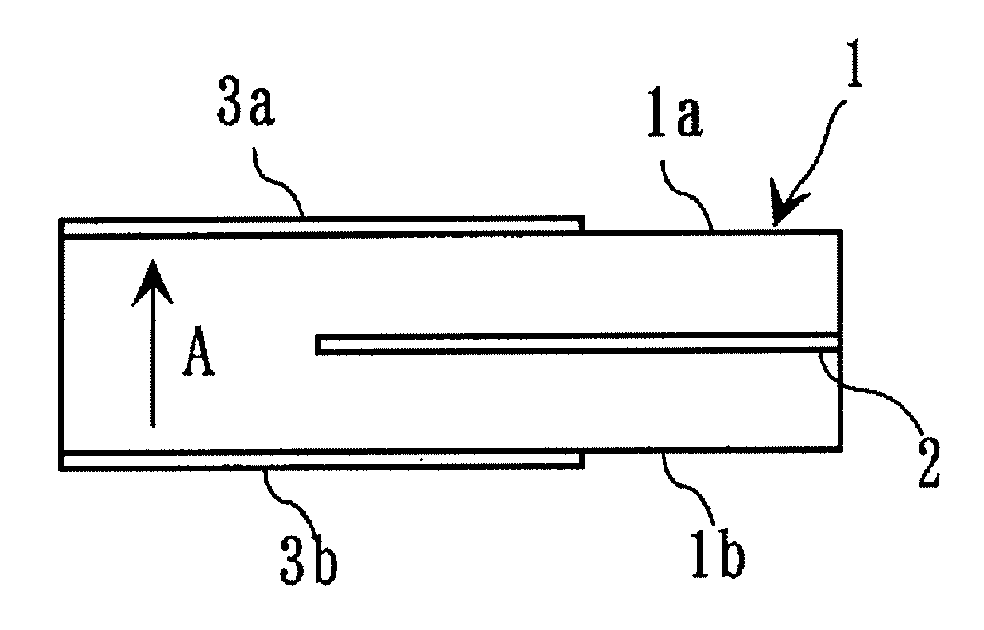Piezoelectric ceramic composition and piezoelectric part
a technology of piezoelectric and ceramics, applied in piezoelectric/electrostrictive/magnetostrictive devices, basic electric elements, generators/motors, etc., can solve the problems of difficult to obtain strong ceramic using lead titanate, pt or pd, and expensive refractory noble metals, etc., to achieve satisfactory piezoelectricity, the effect of resisting reflow heating treatmen
- Summary
- Abstract
- Description
- Claims
- Application Information
AI Technical Summary
Benefits of technology
Problems solved by technology
Method used
Image
Examples
example 1
[0070]As ceramic raw materials, Pb3O4, CaCO3, SrCO3, TiO2, ZnO, and WO6 were prepared.
[0071]The ceramic raw materials were weighed so as to obtain component composition of a final composition as shown in Table 1. Next, these weighed materials were put into the ball mill containing partially-stabilized zirconia, and sufficiently wet blended for about 16 hours using pure water as a solvent, thereby producing a slurry.
[0072]After drying this slurry, it is calcined at a temperature of 900° C. under oxidizing atmosphere, thereby obtaining a calcined compact. After shredding (grinding) the calcined compact, polyvinyl alcohol resin serving as an organic binder was added to the shredded calcined compact, and the binder-added calcined compact were put again into the ball mill containing partially-stabilized zirconia and wet milled for about 16 hours, thereby producing a second slurry. The second slurry was formed into sheets by the doctor blade method, thereby producing ceramic green sheets....
example 2
[0106]MnCO3 was prepared in addition to the ceramic raw materials described in Example 1.
[0107]Next, Pb3O4, CaCO3, SrCO3, TiO2, ZnO, and WO6 were weighed so as to obtain main component composition of (Pb0.8Ca0.1Sr0.1) {Ti0.95 (Zn1 / 2W1 / 2)0.05}O3. The MnCO3 was weighed so as to have a content shown in Table 3 with respect to 100 weight parts of the main component.
[0108]Thereafter, samples 31 to 35 were produced by similar method and procedures to those of Example 1. The firing temperature was set to 1100° C. for all of the samples 31 to 35.
[0109]Next, the sintered density, electromechanical coupling factor kp by thickness longitudinal oscillation, mechanical quality factor Qm, Curie point Tc, and temperature rate of change |frTC| of an resonance frequency of each of the samples 31 to 35 were measured by similar method and procedures to those of Example 1.
[0110]The Table 3 shows constituent components and firing temperatures of the samples 31 to 35, and Table 4 shows measurement result...
PUM
| Property | Measurement | Unit |
|---|---|---|
| temperature | aaaaa | aaaaa |
| temperature | aaaaa | aaaaa |
| Curie points Tc | aaaaa | aaaaa |
Abstract
Description
Claims
Application Information
 Login to View More
Login to View More - R&D
- Intellectual Property
- Life Sciences
- Materials
- Tech Scout
- Unparalleled Data Quality
- Higher Quality Content
- 60% Fewer Hallucinations
Browse by: Latest US Patents, China's latest patents, Technical Efficacy Thesaurus, Application Domain, Technology Topic, Popular Technical Reports.
© 2025 PatSnap. All rights reserved.Legal|Privacy policy|Modern Slavery Act Transparency Statement|Sitemap|About US| Contact US: help@patsnap.com


